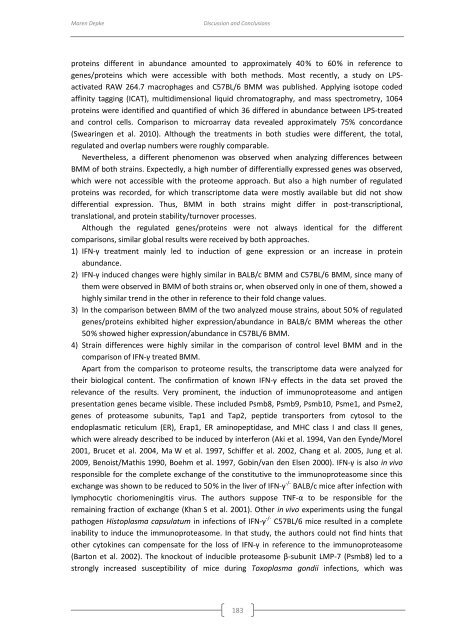genomewide characterization of host-pathogen interactions by ...
genomewide characterization of host-pathogen interactions by ...
genomewide characterization of host-pathogen interactions by ...
Create successful ePaper yourself
Turn your PDF publications into a flip-book with our unique Google optimized e-Paper software.
Maren Depke<br />
Discussion and Conclusions<br />
proteins different in abundance amounted to approximately 40 % to 60 % in reference to<br />
genes/proteins which were accessible with both methods. Most recently, a study on LPSactivated<br />
RAW 264.7 macrophages and C57BL/6 BMM was published. Applying isotope coded<br />
affinity tagging (ICAT), multidimensional liquid chromatography, and mass spectrometry, 1064<br />
proteins were identified and quantified <strong>of</strong> which 36 differed in abundance between LPS-treated<br />
and control cells. Comparison to microarray data revealed approximately 75% concordance<br />
(Swearingen et al. 2010). Although the treatments in both studies were different, the total,<br />
regulated and overlap numbers were roughly comparable.<br />
Nevertheless, a different phenomenon was observed when analyzing differences between<br />
BMM <strong>of</strong> both strains. Expectedly, a high number <strong>of</strong> differentially expressed genes was observed,<br />
which were not accessible with the proteome approach. But also a high number <strong>of</strong> regulated<br />
proteins was recorded, for which transcriptome data were mostly available but did not show<br />
differential expression. Thus, BMM in both strains might differ in post-transcriptional,<br />
translational, and protein stability/turnover processes.<br />
Although the regulated genes/proteins were not always identical for the different<br />
comparisons, similar global results were received <strong>by</strong> both approaches.<br />
1) IFN-γ treatment mainly led to induction <strong>of</strong> gene expression or an increase in protein<br />
abundance.<br />
2) IFN-γ induced changes were highly similar in BALB/c BMM and C57BL/6 BMM, since many <strong>of</strong><br />
them were observed in BMM <strong>of</strong> both strains or, when observed only in one <strong>of</strong> them, showed a<br />
highly similar trend in the other in reference to their fold change values.<br />
3) In the comparison between BMM <strong>of</strong> the two analyzed mouse strains, about 50 % <strong>of</strong> regulated<br />
genes/proteins exhibited higher expression/abundance in BALB/c BMM whereas the other<br />
50 % showed higher expression/abundance in C57BL/6 BMM.<br />
4) Strain differences were highly similar in the comparison <strong>of</strong> control level BMM and in the<br />
comparison <strong>of</strong> IFN-γ treated BMM.<br />
Apart from the comparison to proteome results, the transcriptome data were analyzed for<br />
their biological content. The confirmation <strong>of</strong> known IFN-γ effects in the data set proved the<br />
relevance <strong>of</strong> the results. Very prominent, the induction <strong>of</strong> immunoproteasome and antigen<br />
presentation genes became visible. These included Psmb8, Psmb9, Psmb10, Psme1, and Psme2,<br />
genes <strong>of</strong> proteasome subunits, Tap1 and Tap2, peptide transporters from cytosol to the<br />
endoplasmatic reticulum (ER), Erap1, ER aminopeptidase, and MHC class I and class II genes,<br />
which were already described to be induced <strong>by</strong> interferon (Aki et al. 1994, Van den Eynde/Morel<br />
2001, Brucet et al. 2004, Ma W et al. 1997, Schiffer et al. 2002, Chang et al. 2005, Jung et al.<br />
2009, Benoist/Mathis 1990, Boehm et al. 1997, Gobin/van den Elsen 2000). IFN-γ is also in vivo<br />
responsible for the complete exchange <strong>of</strong> the constitutive to the immunoproteasome since this<br />
exchange was shown to be reduced to 50 % in the liver <strong>of</strong> IFN-γ -/- BALB/c mice after infection with<br />
lymphocytic choriomeningitis virus. The authors suppose TNF-α to be responsible for the<br />
remaining fraction <strong>of</strong> exchange (Khan S et al. 2001). Other in vivo experiments using the fungal<br />
<strong>pathogen</strong> Histoplasma capsulatum in infections <strong>of</strong> IFN-γ -/- C57BL/6 mice resulted in a complete<br />
inability to induce the immunoproteasome. In that study, the authors could not find hints that<br />
other cytokines can compensate for the loss <strong>of</strong> IFN-γ in reference to the immunoproteasome<br />
(Barton et al. 2002). The knockout <strong>of</strong> inducible proteasome β-subunit LMP-7 (Psmb8) led to a<br />
strongly increased susceptibility <strong>of</strong> mice during Toxoplasma gondii infections, which was<br />
183

















